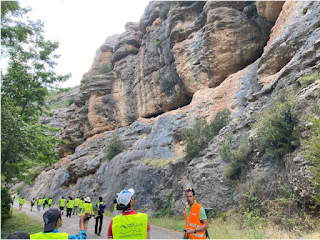ITN opportunities: Summer-schools (Part 2)

Inside Africa: Fossil source-to-sink systems, the diamond case and an eolian story, Namibia, 2023 In May 2023, from the 06th to the 20th, we travelled 3500 kms through Namibia to follow two different source-to-sink systems: the diamond system in the South and the aeolian system further north. Figure 1 Bogenfels ghost town, Sperrgebiet - Farewell at the Pink House The story of the diamonds is both old and young and starts with the diamonds being created within Jurassic Large Igneous Provinces - fields of volcanoes that were supplied with magma from the base of very thick and old continents and therefore can contain diamonds - all over Southern Africa. The craters were then eroded, sediments deposited in a sedimentary basin, which eventually was eroded too. The transport was interrupted by multiple tectonic tilts of the South African Plateau which impacted erosion and sediment transport, while extreme climate formed thick weathering profiles and crusts and thus enrich...



